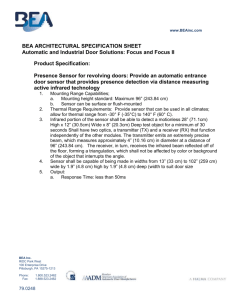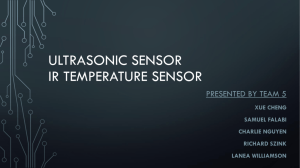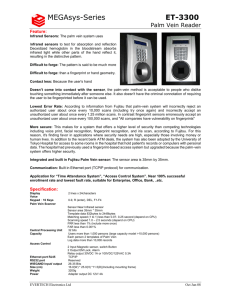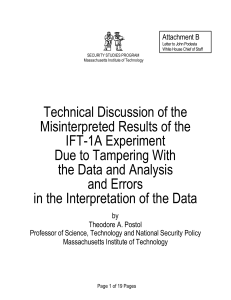Explanation of Why the Sensor in the Exoatmospheric Kill Vehicle
advertisement
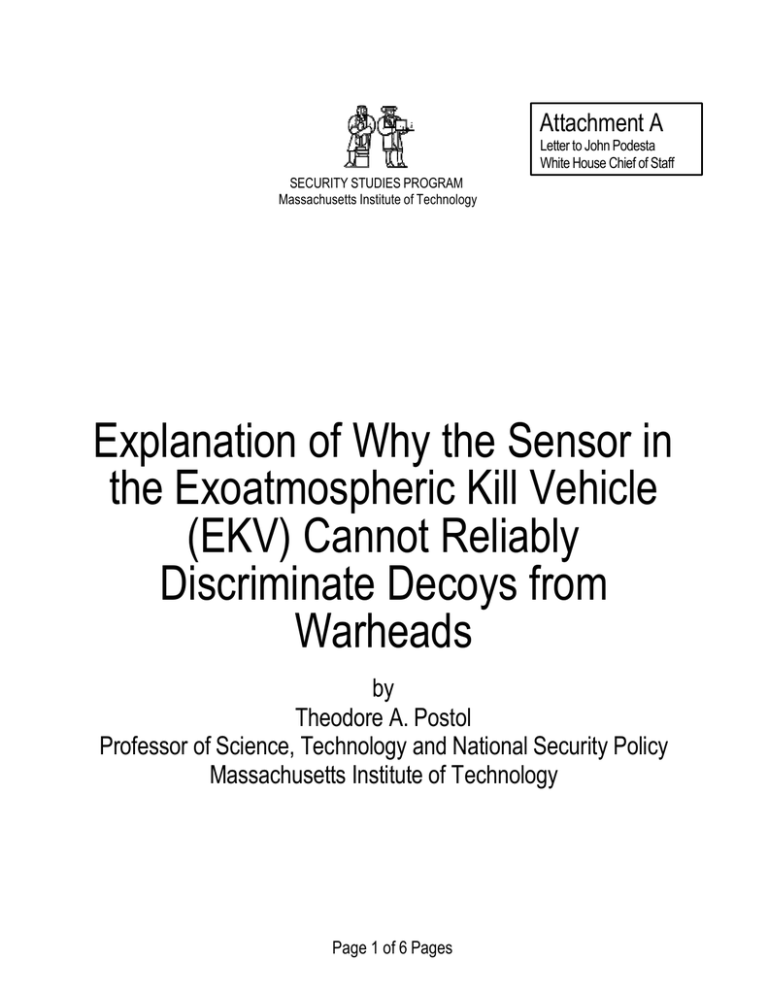
Attachment A Letter to John Podesta White House Chief of Staff SECURITY STUDIES PROGRAM Massachusetts Institute of Technology Explanation of Why the Sensor in the Exoatmospheric Kill Vehicle (EKV) Cannot Reliably Discriminate Decoys from Warheads by Theodore A. Postol Professor of Science, Technology and National Security Policy Massachusetts Institute of Technology Page 1 of 6 Pages Why the Exoatmospheric Kill Vehicle Sensor Cannot Reliably Discriminate Decoys from Warheads Page 2 of 6 Pages Attachment A of Letter to White House Chief of Staff by T. A. Postol Explanation of Why the Sensor in the Exoatmospheric Kill Vehicle (EKV) Cannot Reliably Discriminate Decoys from Warheads by Theodore A. Postol Professor of Science, technology and National Security Policy Massachusetts Institute of Technology Introduction The Integrated Flight Test 1A (IFT-1A) was a very critical test of the sensor technology that is to be used in the Exoatmospheric Kill Vehicle (EKV). Its purpose was to flyby a complex of ten targets to gather “signature” information on objects that were deployed in space, and to use this signature information to determine how effective the kill vehicle sensor will be in identifying warheads that are mixed in with light decoys. Ten targets were used in the IFT-1A experiment – one mock warhead, and nine balloons of various size, shape, and surface coatings. Each of the targets contained instruments that measured and reported their location in space. In addition, as the kill vehicle sensor platform coasted towards the complex of targets, data on all objects in the sensor’s field of view was transmitted to the ground for post-flight analysis. Thus, the IFT-1A experiment was a highly controlled and instrumented experiment designed to collect sensor data on objects that were fully characterized and traveling through space . The subsequent analysis of the IFT-1A data was then supposed to be used to evaluate how effective the EKV sensor would be against objects where their detailed characteristics are unknown. For reasons that will be described in Attachment B, subsequent analysis of the sensor data from the IFT-1A experiment reveals that the sensor data contains essentially no information that uniquely identifies the warhead. As a result, the EKV has a very low probability of selecting warheads among decoys. The IFT-1A experiment simply showed that the physical motions of light and heavy objects in the near vacuum of space are sufficiently similar that objects cannot be selected by simply measuring the fluctuations in their brightness as they tumble, spin, and/or precess. Stated differently, light and heavy objects will tumble, spin, and/or precess in the same way as long as they have the same distribution of mass (more accurately, as long as the light and heavy objects have the same ratios of moments of inertia, they will have the same physical dynamics in space). Thus very simple decoys will predictably have the effect of drastically reducing the probability of intercept of the current National Missile Defense, resulting in a defense that could readily be defeated by the most technologically primitive of adversaries. How the Exotamospheric Kill Vehicle (EKV) Picks Its Target The Exoatmospheric Kill Vehicle contains a telescope that can observe targets in the visible and at least two infrared wavelengths. The exact resolution of the telescope is classified, but it is easy to show that it should have an angular resolution of roughly 150 to 300 microradians. This Why the Exoatmospheric Kill Vehicle Sensor Cannot Reliably Discriminate Decoys from Warheads Page 3 of 6 Pages Attachment A of Letter to White House Chief of Staff by T. A. Postol means that the resolution of the EKV against objects at 1000 kilometers range is between 150 and 300 meters, and even at 10 kilometers range, the resolution will be roughly 1.5 to 3 meters. The figure below shows roughly how the Exoatmospheric Kill Vehicle would see a Mark12A Minuteman III warhead at a range of 3 to 6 kilometers. The Mark12A is roughly 6 feet long (1.83 meters) and has a base diameter of 22 inches (about .56 meters). Minuteman Mark 12A Warhead Minuteman Mark 12A Warhead as Seen By the Exoatmospheric Kill Vehicle at 3 to 6 Kilometers Range When the EKV is 3 to 6 kilometers from a target, it has less than half of a second to maneuver before impact with the target. At this point in the homing process, the EKV has either picked the right target or it has failed. Since the EKV must pick the target it is to home against many tens of seconds prior to impact, it must be able to identify both warheads and decoys at ranges of many hundreds of kilometers. As a result, all objects simply appear like points of light to the EKV during the time it must determine which objects are warheads and which are decoys. This is achieved by exploiting the fact that the infrared signal from a space-object will vary as a function of the projected area observed by the EKV sensor. As each space-object rotates, precesses, and/or tumbles, the projected area seen by the EKV sensor changes, resulting in a signal that is a point of light with a time-changing intensity for each object. The figure and graph below show how the projected area of a simple cone changes with aspect angle. 0° 12.5° 20° 40° 60° 80° 90° 120° 140° Front-On 1.0 0.9 Total Projected Area 0.7 tum us Fr Projected Area (m 2) 0.8 0.6 0.5 0.4 0.3 Ba se 0.2 0.1 0.0 Nose Tip 0 20 40 60 80 100 120 140 160 180 Aspect Angle (degrees) Projected Area of a Cone-Target as a Function of Aspect Angle (Zero Degrees is Nose-On) (Note: Kill Vehicle sees only a single pixel or dot) Why the Exoatmospheric Kill Vehicle Sensor Cannot Reliably Discriminate Decoys from Warheads Page 4 of 6 Pages Attachment A of Letter to White House Chief of Staff by T. A. Postol In reality, the infrared signal from tumbling or precessing space objects will also depend on their temperature and the emissivity of the surface materials attached to them. Just as the surface appearance of a bare piece of metal can be changed by polishing, or by painting, so can the emissivity of an object be changed. As a result, the signal intensity from the same object can be different if the different surfaces of the object are simply covered by materials with different emissivities. This is illustrated below for a cone with a half angle of about 12.5 degrees. Cone Frustum Emissivity = 0.15 Relative Intensity of the Infrared Signal from the Projected Area of a Cone as a Function of the Angle of Rotation from the Nose 1.0 1.0 0.9 0.8 Total Infrared Signal from Projected Area of the Base and Frustum 0.7 Relative Intensity of the Infrared Signal from the Warhead Relative Intensity of the Infrared Signal from the Warhead Cone Frustum Emissivity = 0.55 Relative Intensity of the Infrared Signal from the Projected Area of a Cone as a Function of the Angle of Rotation from the Nose Component of Signal from the Cone's Base 0.6 e =1.0 0.5 0.4 0.3 Component of Signal from the Cone's Frustum e =0.15 0.2 0.1 0.9 Total Infrared Signal from Projected Area of the Base and Frustum 0.8 0.7 Component of Signal from the Cone's Base 0.6 e =1.0 0.5 Component of Signal from the Cone's Frustum 0.4 e =0.55 0.3 0.2 0.1 Nose Tip 0.0 0 20 Nose Tip 0.0 40 60 80 100 Aspect Angle (degrees) 120 140 160 180 0 20 40 60 80 100 120 140 160 180 Aspect Angle (degrees) Making matters even more complex, is that the absolute value of the intensity and the way it fluctuates will change with the angle of orientation of a tumbling or precessing object. This can be easily seen by inspection of the figure at the bottom of this page, which shows the projected areas of a cone at five different times during its precessing motions. If the cone frustum is covered with materials that have the same emissivity, and it is seen nose-on (see Nose-On View in figure below), the change in the projected area as the warhead precesses will be quite small, and so will the magnitiude in the fluctuation in the signal. If the cone is instead viewed side on, there may be intermittent intervals where the base presents itself to the sensor (Side-On View 1) causing aperiodic intermittent spikes in the infrared signal. When viewed from other observation angles, the base may be fully in view, resulting in a large oscillating component in the infrared signal (Side-On View 2), or it may not be in view (Side-On View 3), resulting in significantly diminished oscillations in the infrared signal. Nose-On View Side-On View 1 Side-On View 2 Side-On View 3 Why the Exoatmospheric Kill Vehicle Sensor Cannot Reliably Discriminate Decoys from Warheads Page 5 of 6 Pages Attachment A of Letter to White House Chief of Staff by T. A. Postol In summary, the EKV sees targets as only fluctuating points of light. The fluctuations in the signal from targets are due to changes in their orientation as they precess, rotate, and/or tumble in space. The absolute magnitude of infrared signals from objects will depend on their temperature, surface coatings, geometry, and size. All of these characteristics can be controlled and altered by an adversary. Thus, the only hope the EKV has to discriminate light decoys from heavy warheads is if the motions of the heavy warheads are different in an identifiable way from the motions of decoys. This will not be the case if the decoys are designed so that the ratio of their moments of inertia are the same. It is also possible to package the warhead in a balloon, so the infrared signal from it cannot be observed, or the infrared signal from the warhead can be modified by tethering objects to the warhead that cannot be resolved by the EKV, but lead to fluctuations in the signal that have nothing to do with the physical characteristics of the warhead. Thus, it is no surprise that even under the highly orchestrated conditions of the IFT-1A experiment, the sensor flyby data showed that for at least some of the objects, there were no features in the data to indicate that they were not the warhead. Some Photos of Objects that Could Appear Like Warheads Infrared Signal from Deployed Objects Objects Deployed from the Post-Boost Vehicle Post-Boost Vehicle Infrared and Visible Data from Midcourse Space Experiment Dedicated Target Mission (MDT II) Infrared Data Taken by the Space Infrared Imaging Telescope (SPIRIT III) in the Mid-Course Space Experiment (MSX) Payload Visible Signal from Deployed Objects Why the Exoatmospheric Kill Vehicle Sensor Cannot Reliably Discriminate Decoys from Warheads Large Balloon With Reflecting Coating Light Rigid Replica Decoy Page 6 of 6 Pages Attachment A of Letter to White House Chief of Staff by T. A. Postol 2.2 Meter Diameter Balloon With Black Coating Minuteman Inflatable Decoy Balloon With White Coating Minuteman Warhead


